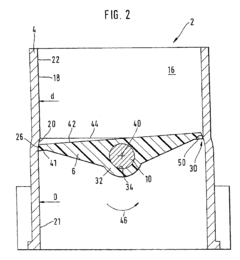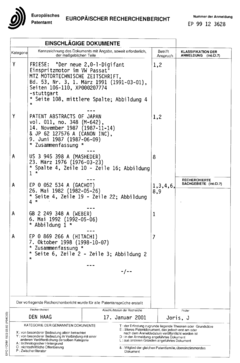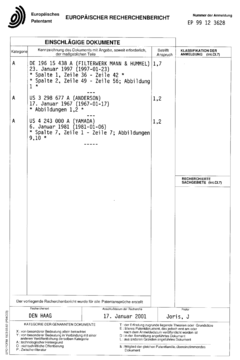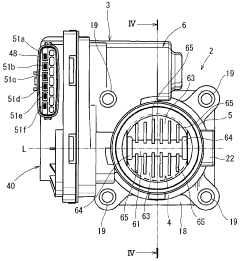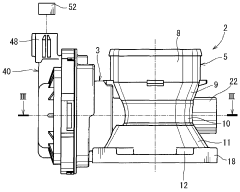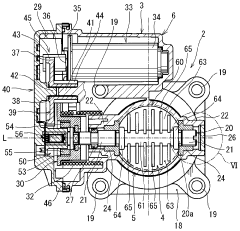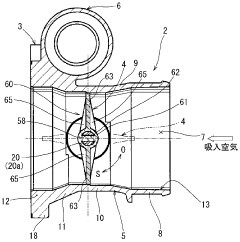How Throttle Body Design Affects Power Generation Reliability
JUL 18, 20259 MIN READ
Generate Your Research Report Instantly with AI Agent
Patsnap Eureka helps you evaluate technical feasibility & market potential.
Throttle Body Evolution
The throttle body has undergone significant evolution since its inception, playing a crucial role in engine performance and power generation reliability. Initially designed as a simple mechanical device, the throttle body has transformed into a sophisticated electronic component, reflecting the broader trends in automotive technology.
In the early days of internal combustion engines, throttle bodies were purely mechanical, consisting of a butterfly valve controlled by a cable connected to the accelerator pedal. This design, while functional, had limitations in terms of precision and responsiveness. As engines became more complex and demands for fuel efficiency increased, the need for more advanced throttle body designs became apparent.
The introduction of electronic fuel injection systems in the 1980s marked a significant milestone in throttle body evolution. This led to the development of electronic throttle control (ETC) systems, also known as drive-by-wire technology. ETC replaced the mechanical linkage between the accelerator pedal and the throttle body with electronic sensors and actuators, allowing for more precise control of the throttle opening.
Further advancements came with the integration of idle air control (IAC) valves into the throttle body. These valves helped maintain a stable idle speed and improved engine performance during cold starts. The incorporation of IAC functionality into the throttle body design simplified the overall engine management system and enhanced reliability.
As emissions regulations became more stringent, throttle body designs evolved to accommodate better air-fuel mixture control. This led to the development of multi-port injection systems, where fuel injectors were placed closer to the intake valves. While this reduced the throttle body's role in fuel delivery, it remained critical for airflow regulation.
Recent years have seen the emergence of variable geometry throttle bodies, capable of adjusting their shape and airflow characteristics based on engine demand. This innovation allows for optimized performance across a wider range of operating conditions, contributing to improved power generation reliability and fuel efficiency.
The integration of advanced sensors and microprocessors into throttle body designs has further enhanced their capabilities. Modern throttle bodies can now communicate with other engine management systems in real-time, allowing for adaptive control strategies that optimize performance based on various factors such as altitude, temperature, and driving conditions.
As the automotive industry moves towards electrification, the role of the throttle body is evolving once again. In hybrid and electric vehicles, throttle bodies are being adapted to manage airflow in new ways, supporting regenerative braking systems and optimizing the interplay between electric motors and internal combustion engines in hybrid powertrains.
In the early days of internal combustion engines, throttle bodies were purely mechanical, consisting of a butterfly valve controlled by a cable connected to the accelerator pedal. This design, while functional, had limitations in terms of precision and responsiveness. As engines became more complex and demands for fuel efficiency increased, the need for more advanced throttle body designs became apparent.
The introduction of electronic fuel injection systems in the 1980s marked a significant milestone in throttle body evolution. This led to the development of electronic throttle control (ETC) systems, also known as drive-by-wire technology. ETC replaced the mechanical linkage between the accelerator pedal and the throttle body with electronic sensors and actuators, allowing for more precise control of the throttle opening.
Further advancements came with the integration of idle air control (IAC) valves into the throttle body. These valves helped maintain a stable idle speed and improved engine performance during cold starts. The incorporation of IAC functionality into the throttle body design simplified the overall engine management system and enhanced reliability.
As emissions regulations became more stringent, throttle body designs evolved to accommodate better air-fuel mixture control. This led to the development of multi-port injection systems, where fuel injectors were placed closer to the intake valves. While this reduced the throttle body's role in fuel delivery, it remained critical for airflow regulation.
Recent years have seen the emergence of variable geometry throttle bodies, capable of adjusting their shape and airflow characteristics based on engine demand. This innovation allows for optimized performance across a wider range of operating conditions, contributing to improved power generation reliability and fuel efficiency.
The integration of advanced sensors and microprocessors into throttle body designs has further enhanced their capabilities. Modern throttle bodies can now communicate with other engine management systems in real-time, allowing for adaptive control strategies that optimize performance based on various factors such as altitude, temperature, and driving conditions.
As the automotive industry moves towards electrification, the role of the throttle body is evolving once again. In hybrid and electric vehicles, throttle bodies are being adapted to manage airflow in new ways, supporting regenerative braking systems and optimizing the interplay between electric motors and internal combustion engines in hybrid powertrains.
Power Gen Market Trends
The power generation market is experiencing significant shifts driven by global energy transitions and technological advancements. A key trend is the increasing focus on renewable energy sources, with wind and solar power gaining substantial market share. This shift is reshaping the traditional power generation landscape, pushing conventional thermal power plants to adapt and improve their efficiency and reliability.
In response to environmental concerns and stringent regulations, there is a growing demand for cleaner and more efficient power generation technologies. This has led to increased investment in combined cycle gas turbines (CCGTs) and the modernization of existing coal-fired plants with advanced emission control systems. The market is also witnessing a rise in distributed generation, with smaller, localized power sources becoming more prevalent.
Digitalization and the integration of smart technologies are transforming power plant operations. Advanced sensors, data analytics, and artificial intelligence are being employed to optimize performance, predict maintenance needs, and enhance overall reliability. This trend is particularly relevant to throttle body design, as these digital solutions can provide real-time insights into system performance and potential issues.
The global power generation equipment market is projected to grow steadily, driven by increasing electricity demand in developing economies and the need to replace aging infrastructure in developed countries. However, market dynamics vary significantly across regions, with emerging markets focusing on capacity expansion while mature markets prioritize efficiency improvements and emissions reduction.
Reliability and flexibility have become critical factors in power generation, especially with the increasing integration of intermittent renewable sources. This has led to a growing emphasis on technologies that can provide quick start-up and load-following capabilities, where throttle body design plays a crucial role in ensuring responsive and stable power output.
Energy storage solutions are gaining prominence in the power generation market, complementing traditional generation methods and enabling better grid stability. This trend is influencing the design requirements for power generation equipment, including throttle bodies, to ensure compatibility with hybrid systems incorporating storage technologies.
The market is also seeing increased interest in alternative fuels, such as hydrogen and synthetic fuels, as part of decarbonization efforts. This shift is driving innovation in power generation equipment design, including throttle bodies, to accommodate these new fuel types while maintaining reliability and efficiency.
In response to environmental concerns and stringent regulations, there is a growing demand for cleaner and more efficient power generation technologies. This has led to increased investment in combined cycle gas turbines (CCGTs) and the modernization of existing coal-fired plants with advanced emission control systems. The market is also witnessing a rise in distributed generation, with smaller, localized power sources becoming more prevalent.
Digitalization and the integration of smart technologies are transforming power plant operations. Advanced sensors, data analytics, and artificial intelligence are being employed to optimize performance, predict maintenance needs, and enhance overall reliability. This trend is particularly relevant to throttle body design, as these digital solutions can provide real-time insights into system performance and potential issues.
The global power generation equipment market is projected to grow steadily, driven by increasing electricity demand in developing economies and the need to replace aging infrastructure in developed countries. However, market dynamics vary significantly across regions, with emerging markets focusing on capacity expansion while mature markets prioritize efficiency improvements and emissions reduction.
Reliability and flexibility have become critical factors in power generation, especially with the increasing integration of intermittent renewable sources. This has led to a growing emphasis on technologies that can provide quick start-up and load-following capabilities, where throttle body design plays a crucial role in ensuring responsive and stable power output.
Energy storage solutions are gaining prominence in the power generation market, complementing traditional generation methods and enabling better grid stability. This trend is influencing the design requirements for power generation equipment, including throttle bodies, to ensure compatibility with hybrid systems incorporating storage technologies.
The market is also seeing increased interest in alternative fuels, such as hydrogen and synthetic fuels, as part of decarbonization efforts. This shift is driving innovation in power generation equipment design, including throttle bodies, to accommodate these new fuel types while maintaining reliability and efficiency.
Throttle Design Challenges
The design of throttle bodies presents several significant challenges that directly impact power generation reliability in engines. One of the primary issues is achieving precise airflow control across a wide range of operating conditions. Engineers must balance the need for smooth, consistent airflow at low engine speeds with the requirement for maximum airflow during high-demand situations. This delicate balance often leads to compromises in design that can affect overall engine performance and reliability.
Material selection for throttle bodies is another critical challenge. The components must withstand high temperatures, resist corrosion from fuel and exhaust gases, and maintain dimensional stability over time. Thermal expansion and contraction can cause warping or sticking of the throttle plate, leading to inconsistent airflow and potential power loss. Additionally, the choice of materials impacts the manufacturing cost and durability of the throttle body, which are important considerations for both manufacturers and end-users.
The integration of electronic control systems with mechanical throttle components presents further complexities. Modern throttle bodies often incorporate sensors and actuators to enable precise control and communication with the engine management system. Ensuring the reliability and accuracy of these electronic components in harsh engine environments is crucial for maintaining consistent power output and fuel efficiency. Electromagnetic interference and vibration can also affect the performance of these sensitive electronic systems.
Sealing and leakage prevention pose ongoing challenges in throttle body design. Even minor air leaks around the throttle plate or body can lead to inconsistent air-fuel mixtures, affecting engine performance and emissions. Designers must develop effective sealing solutions that maintain their integrity over the lifespan of the engine, considering factors such as thermal cycling, vibration, and wear.
The increasing demand for improved fuel efficiency and reduced emissions adds another layer of complexity to throttle body design. Engineers must optimize airflow characteristics to support advanced combustion strategies, such as lean-burn technologies or variable valve timing systems. This often requires more sophisticated throttle body geometries and control mechanisms, which can introduce additional points of failure if not carefully engineered.
Manufacturing tolerances and quality control present ongoing challenges in throttle body production. Tight tolerances are necessary to ensure consistent performance across all units, but achieving these tolerances cost-effectively at scale can be difficult. Variations in manufacturing can lead to differences in airflow characteristics between individual throttle bodies, potentially affecting engine power output and reliability.
As engines continue to evolve, throttle body designers must also address the challenges of downsizing and turbocharging. These trends require throttle bodies to handle higher pressures and temperatures while maintaining precise control over a wider range of operating conditions. Adapting throttle body designs to these new engine architectures without compromising reliability or performance is an ongoing area of research and development in the automotive industry.
Material selection for throttle bodies is another critical challenge. The components must withstand high temperatures, resist corrosion from fuel and exhaust gases, and maintain dimensional stability over time. Thermal expansion and contraction can cause warping or sticking of the throttle plate, leading to inconsistent airflow and potential power loss. Additionally, the choice of materials impacts the manufacturing cost and durability of the throttle body, which are important considerations for both manufacturers and end-users.
The integration of electronic control systems with mechanical throttle components presents further complexities. Modern throttle bodies often incorporate sensors and actuators to enable precise control and communication with the engine management system. Ensuring the reliability and accuracy of these electronic components in harsh engine environments is crucial for maintaining consistent power output and fuel efficiency. Electromagnetic interference and vibration can also affect the performance of these sensitive electronic systems.
Sealing and leakage prevention pose ongoing challenges in throttle body design. Even minor air leaks around the throttle plate or body can lead to inconsistent air-fuel mixtures, affecting engine performance and emissions. Designers must develop effective sealing solutions that maintain their integrity over the lifespan of the engine, considering factors such as thermal cycling, vibration, and wear.
The increasing demand for improved fuel efficiency and reduced emissions adds another layer of complexity to throttle body design. Engineers must optimize airflow characteristics to support advanced combustion strategies, such as lean-burn technologies or variable valve timing systems. This often requires more sophisticated throttle body geometries and control mechanisms, which can introduce additional points of failure if not carefully engineered.
Manufacturing tolerances and quality control present ongoing challenges in throttle body production. Tight tolerances are necessary to ensure consistent performance across all units, but achieving these tolerances cost-effectively at scale can be difficult. Variations in manufacturing can lead to differences in airflow characteristics between individual throttle bodies, potentially affecting engine power output and reliability.
As engines continue to evolve, throttle body designers must also address the challenges of downsizing and turbocharging. These trends require throttle bodies to handle higher pressures and temperatures while maintaining precise control over a wider range of operating conditions. Adapting throttle body designs to these new engine architectures without compromising reliability or performance is an ongoing area of research and development in the automotive industry.
Current Throttle Solutions
01 Throttle body design optimization
Improving the design of throttle bodies to enhance power generation reliability. This includes optimizing the shape, size, and materials of the throttle body components to reduce wear, improve airflow, and increase overall efficiency.- Throttle body design optimization: Improving the design of throttle bodies to enhance power generation reliability. This includes optimizing the shape, size, and materials of the throttle body components to reduce wear, improve airflow control, and increase overall efficiency.
- Electronic throttle control systems: Implementing advanced electronic throttle control systems to improve power generation reliability. These systems use sensors and actuators to precisely control throttle position, resulting in better engine performance and fuel efficiency.
- Throttle body cleaning and maintenance: Developing methods and devices for efficient cleaning and maintenance of throttle bodies to ensure consistent power generation reliability. This includes automated cleaning systems and improved maintenance schedules to prevent carbon buildup and other issues that can affect performance.
- Integration with energy recovery systems: Combining throttle body technology with energy recovery systems to enhance overall power generation reliability. This involves capturing and utilizing waste energy from the throttle body operation to improve engine efficiency and reduce fuel consumption.
- Throttle body sensors and diagnostics: Incorporating advanced sensors and diagnostic systems into throttle bodies to monitor performance and detect potential issues early. This helps maintain power generation reliability by allowing for predictive maintenance and real-time adjustments to throttle operation.
02 Electronic throttle control systems
Implementing advanced electronic throttle control systems to improve power generation reliability. These systems use sensors and actuators to precisely control throttle position, resulting in better engine performance and fuel efficiency.Expand Specific Solutions03 Throttle body cleaning and maintenance
Developing methods and devices for efficient cleaning and maintenance of throttle bodies to ensure consistent power generation reliability. This includes automated cleaning systems and improved maintenance schedules to prevent carbon buildup and other issues that can affect performance.Expand Specific Solutions04 Integration of power generation components
Integrating power generation components directly into the throttle body assembly to improve overall system reliability. This approach can reduce the number of separate components, minimize potential failure points, and enhance energy efficiency.Expand Specific Solutions05 Throttle body monitoring and diagnostics
Implementing advanced monitoring and diagnostic systems for throttle bodies to detect and prevent potential issues that could affect power generation reliability. This includes real-time performance analysis, predictive maintenance algorithms, and early warning systems for component failures.Expand Specific Solutions
Key Throttle Manufacturers
The throttle body design market is in a mature stage, with established players and well-developed technologies. The global market size is estimated to be in the billions of dollars, driven by increasing demand for fuel-efficient vehicles and stringent emission regulations. Key players like Bosch, Siemens, and Continental Automotive have advanced R&D capabilities and extensive product portfolios. Emerging companies from Asia, such as Aisan Industry and Wuxi Longsheng Technology, are also gaining market share. The technology is relatively mature, with ongoing innovations focused on improving precision, durability, and integration with electronic control systems. Major automakers like Volkswagen, Toyota, and Honda are actively collaborating with suppliers to enhance throttle body performance and reliability in their vehicles.
Robert Bosch GmbH
Technical Solution: Bosch has developed advanced electronic throttle body systems that utilize precise control algorithms and high-quality sensors to optimize air intake and fuel mixture. Their design incorporates a dual-spring failsafe mechanism and self-cleaning features to enhance reliability[1]. The company's throttle bodies use a brushless DC motor for accurate positioning and reduced wear. Bosch has also implemented adaptive learning capabilities in their throttle control modules, allowing for real-time adjustments based on engine performance and environmental conditions[2]. This approach ensures consistent power delivery and improved fuel efficiency across various operating conditions.
Strengths: High precision control, robust failsafe mechanisms, and adaptive learning capabilities. Weaknesses: Potentially higher cost due to advanced features and may require specialized diagnostic tools for maintenance.
Continental Automotive GmbH
Technical Solution: Continental's throttle body design emphasizes modularity and scalability to address various engine configurations. Their system uses a high-resolution stepper motor for precise throttle plate positioning, coupled with advanced control algorithms that optimize air-fuel mixture across the entire RPM range[5]. Continental has implemented a self-diagnostic feature that continuously monitors throttle body performance and can detect potential issues before they affect power generation. The company's throttle bodies also incorporate a low-friction bearing design and corrosion-resistant materials to extend service life and maintain consistent performance over time[6].
Strengths: Modular design for various applications, advanced self-diagnostic capabilities, and durable construction. Weaknesses: May require more frequent software updates and could be more sensitive to electrical system fluctuations.
Throttle Design Patents
Throttle body for controlling the power of an engine
PatentInactiveEP1035312A3
Innovation
- A throttle body design with a narrowing gas duct wall and a spherical segment shape, where the axis of rotation is outside the plane of the throttle valve's circumference, allowing for a narrow gap and reduced leakage, and featuring adjustable depressions for precise control, minimizes air leakage and enhances sensitive control of engine power.
Throttle body and method of manufacturing the same
PatentWO2005116420A1
Innovation
- A throttle body design featuring a valve portion with an end face that slides against a bearing member with a radius equal to or larger than the locus of rotation, and optionally incorporating materials or coatings with good lubricity, to reduce frictional resistance and prevent contact with the bore wall, along with integral molding of components to minimize costs and weight.
Emissions Regulations
Emissions regulations play a crucial role in shaping the design and performance of throttle bodies in power generation systems. These regulations, established by environmental agencies worldwide, aim to reduce harmful emissions and promote cleaner energy production. As governments increasingly focus on environmental protection, the impact of these regulations on throttle body design has become more significant.
The primary goal of emissions regulations is to limit the release of pollutants such as nitrogen oxides (NOx), carbon monoxide (CO), and particulate matter (PM) from power generation systems. These regulations often set specific targets for emission levels, which manufacturers must meet to comply with legal requirements. As a result, throttle body designs have evolved to incorporate advanced technologies and materials that help achieve these emission targets while maintaining power generation reliability.
One of the key ways in which emissions regulations affect throttle body design is through the implementation of more precise fuel metering systems. Traditional throttle bodies often relied on simpler mechanical designs, which could lead to inconsistent fuel delivery and higher emissions. Modern throttle bodies, however, incorporate electronic control systems and advanced sensors to optimize fuel-air mixture ratios, resulting in more efficient combustion and reduced emissions.
Another significant impact of emissions regulations on throttle body design is the increased use of variable geometry technologies. These designs allow for dynamic adjustment of the throttle opening based on engine load and operating conditions. By optimizing airflow throughout the engine's operating range, variable geometry throttle bodies can help reduce emissions while maintaining or even improving power output and reliability.
Emissions regulations have also driven the development of integrated exhaust gas recirculation (EGR) systems within throttle body designs. EGR technology helps reduce NOx emissions by recirculating a portion of the exhaust gases back into the combustion chamber, lowering peak combustion temperatures. This integration has led to more complex throttle body designs that must accommodate additional components and control systems.
Furthermore, the push for cleaner emissions has encouraged the use of advanced materials in throttle body construction. Lightweight alloys and composite materials are increasingly being employed to reduce overall system weight and improve thermal management. These materials can help enhance throttle response and durability while contributing to improved fuel efficiency and reduced emissions.
As emissions regulations continue to evolve, throttle body designs must adapt to meet increasingly stringent requirements. This ongoing development process presents both challenges and opportunities for power generation reliability. While more complex designs may introduce new potential failure points, they also offer improved control and efficiency, potentially enhancing overall system reliability when properly implemented and maintained.
The primary goal of emissions regulations is to limit the release of pollutants such as nitrogen oxides (NOx), carbon monoxide (CO), and particulate matter (PM) from power generation systems. These regulations often set specific targets for emission levels, which manufacturers must meet to comply with legal requirements. As a result, throttle body designs have evolved to incorporate advanced technologies and materials that help achieve these emission targets while maintaining power generation reliability.
One of the key ways in which emissions regulations affect throttle body design is through the implementation of more precise fuel metering systems. Traditional throttle bodies often relied on simpler mechanical designs, which could lead to inconsistent fuel delivery and higher emissions. Modern throttle bodies, however, incorporate electronic control systems and advanced sensors to optimize fuel-air mixture ratios, resulting in more efficient combustion and reduced emissions.
Another significant impact of emissions regulations on throttle body design is the increased use of variable geometry technologies. These designs allow for dynamic adjustment of the throttle opening based on engine load and operating conditions. By optimizing airflow throughout the engine's operating range, variable geometry throttle bodies can help reduce emissions while maintaining or even improving power output and reliability.
Emissions regulations have also driven the development of integrated exhaust gas recirculation (EGR) systems within throttle body designs. EGR technology helps reduce NOx emissions by recirculating a portion of the exhaust gases back into the combustion chamber, lowering peak combustion temperatures. This integration has led to more complex throttle body designs that must accommodate additional components and control systems.
Furthermore, the push for cleaner emissions has encouraged the use of advanced materials in throttle body construction. Lightweight alloys and composite materials are increasingly being employed to reduce overall system weight and improve thermal management. These materials can help enhance throttle response and durability while contributing to improved fuel efficiency and reduced emissions.
As emissions regulations continue to evolve, throttle body designs must adapt to meet increasingly stringent requirements. This ongoing development process presents both challenges and opportunities for power generation reliability. While more complex designs may introduce new potential failure points, they also offer improved control and efficiency, potentially enhancing overall system reliability when properly implemented and maintained.
Throttle Reliability Tests
Throttle reliability tests are crucial for assessing the performance and durability of throttle body designs in power generation systems. These tests typically involve a series of rigorous evaluations under various operating conditions to ensure the throttle body can maintain consistent and reliable performance over extended periods.
One key aspect of throttle reliability testing is the endurance test, which subjects the throttle body to prolonged operation cycles. This test simulates real-world usage patterns and helps identify potential wear and tear issues that may arise over time. During the endurance test, the throttle body is cycled through its full range of motion repeatedly, often for thousands or even millions of cycles, to evaluate its mechanical integrity and longevity.
Temperature cycling tests are another critical component of throttle reliability assessment. These tests expose the throttle body to extreme temperature variations, mimicking the diverse environmental conditions it may encounter in different power generation applications. By subjecting the throttle body to rapid temperature changes, engineers can evaluate its thermal expansion characteristics and ensure that it maintains proper functionality across a wide temperature range.
Vibration testing is essential for assessing the throttle body's resilience to mechanical stresses. Power generation systems often operate in environments with significant vibration, which can lead to component fatigue and failure if not properly addressed. Vibration tests typically involve mounting the throttle body on a shaker table and subjecting it to various frequencies and amplitudes of vibration to simulate real-world conditions.
Corrosion resistance tests are conducted to evaluate the throttle body's ability to withstand exposure to corrosive substances commonly encountered in power generation environments. These tests may involve salt spray exposure or immersion in corrosive solutions to assess the effectiveness of protective coatings and materials used in the throttle body design.
Flow characterization tests are performed to measure the throttle body's ability to regulate airflow consistently across its operational range. These tests involve precise measurements of airflow rates at different throttle positions, ensuring that the throttle body can maintain accurate control over the air-fuel mixture in the power generation system.
Leak testing is another critical aspect of throttle reliability assessment. This test evaluates the throttle body's ability to maintain a proper seal when closed, preventing unintended airflow that could affect power generation efficiency or emissions control. Leak tests may involve pressurizing the throttle body and measuring any air loss over time.
Finally, electromagnetic compatibility (EMC) testing is conducted to ensure that the throttle body's electronic components, such as position sensors and actuators, can function reliably in the presence of electromagnetic interference commonly found in power generation environments. These tests evaluate the throttle body's susceptibility to electromagnetic disturbances and its potential to emit electromagnetic radiation that could affect other system components.
One key aspect of throttle reliability testing is the endurance test, which subjects the throttle body to prolonged operation cycles. This test simulates real-world usage patterns and helps identify potential wear and tear issues that may arise over time. During the endurance test, the throttle body is cycled through its full range of motion repeatedly, often for thousands or even millions of cycles, to evaluate its mechanical integrity and longevity.
Temperature cycling tests are another critical component of throttle reliability assessment. These tests expose the throttle body to extreme temperature variations, mimicking the diverse environmental conditions it may encounter in different power generation applications. By subjecting the throttle body to rapid temperature changes, engineers can evaluate its thermal expansion characteristics and ensure that it maintains proper functionality across a wide temperature range.
Vibration testing is essential for assessing the throttle body's resilience to mechanical stresses. Power generation systems often operate in environments with significant vibration, which can lead to component fatigue and failure if not properly addressed. Vibration tests typically involve mounting the throttle body on a shaker table and subjecting it to various frequencies and amplitudes of vibration to simulate real-world conditions.
Corrosion resistance tests are conducted to evaluate the throttle body's ability to withstand exposure to corrosive substances commonly encountered in power generation environments. These tests may involve salt spray exposure or immersion in corrosive solutions to assess the effectiveness of protective coatings and materials used in the throttle body design.
Flow characterization tests are performed to measure the throttle body's ability to regulate airflow consistently across its operational range. These tests involve precise measurements of airflow rates at different throttle positions, ensuring that the throttle body can maintain accurate control over the air-fuel mixture in the power generation system.
Leak testing is another critical aspect of throttle reliability assessment. This test evaluates the throttle body's ability to maintain a proper seal when closed, preventing unintended airflow that could affect power generation efficiency or emissions control. Leak tests may involve pressurizing the throttle body and measuring any air loss over time.
Finally, electromagnetic compatibility (EMC) testing is conducted to ensure that the throttle body's electronic components, such as position sensors and actuators, can function reliably in the presence of electromagnetic interference commonly found in power generation environments. These tests evaluate the throttle body's susceptibility to electromagnetic disturbances and its potential to emit electromagnetic radiation that could affect other system components.
Unlock deeper insights with Patsnap Eureka Quick Research — get a full tech report to explore trends and direct your research. Try now!
Generate Your Research Report Instantly with AI Agent
Supercharge your innovation with Patsnap Eureka AI Agent Platform!
